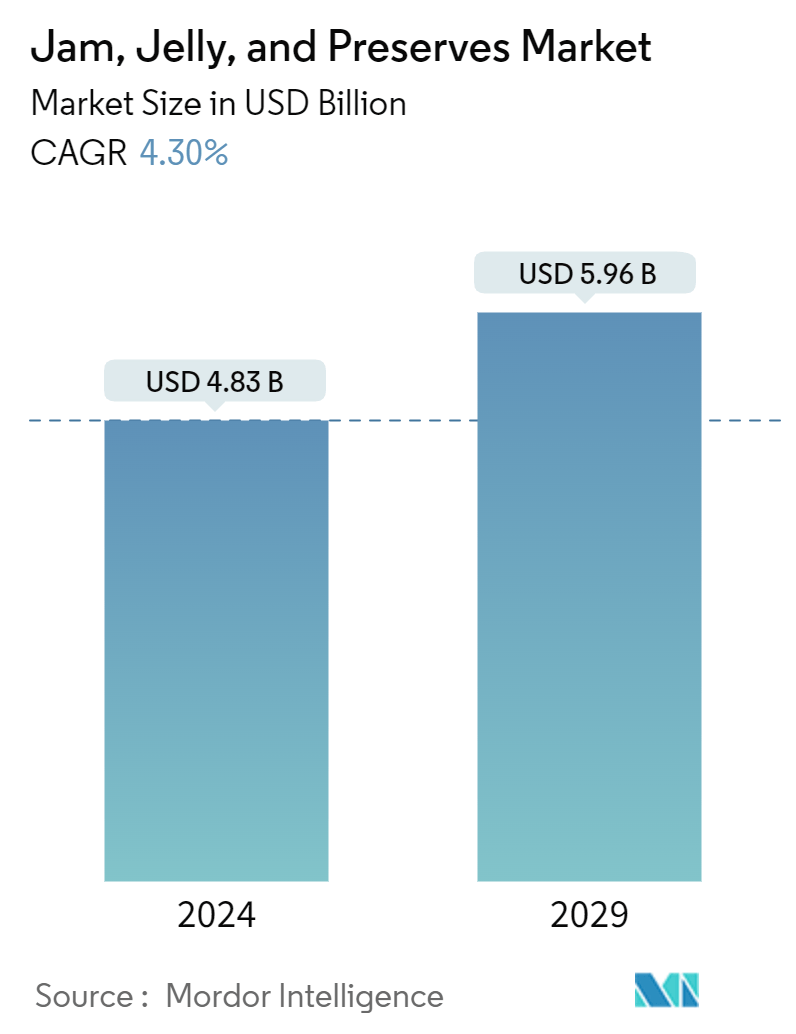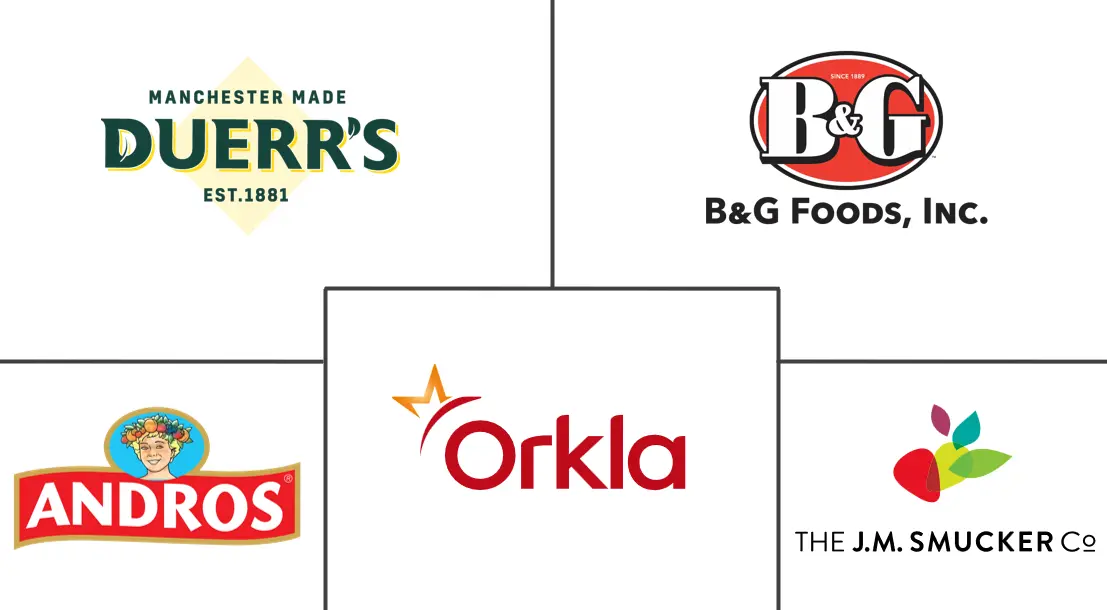Market Size of Jam, Jelly, And Preserves Industry

| Study Period | 2019 - 2029 |
| Market Size (2024) | USD 4.83 Billion |
| Market Size (2029) | USD 5.96 Billion |
| CAGR (2024 - 2029) | 4.30 % |
| Fastest Growing Market | Asia-Pacific |
| Largest Market | North America |
| Market Concentration | Low |
Major Players
*Disclaimer: Major Players sorted in no particular order |
Jam, Jelly, And Preserves Market Analysis
The Jam, Jelly, And Preserves Market size is estimated at USD 4.83 billion in 2024, and is expected to reach USD 5.96 billion by 2029, growing at a CAGR of 4.30% during the forecast period (2024-2029).
Jams, jellies, and preserves are experiencing increasing demand worldwide. In regions like Europe and North America, these products are consumed daily by consumers of all age groups.
Most consumers in developed countries are looking for food spreads without artificial additives, owing to the associated long-term adverse health effects. Manufacturers are inclined toward using natural flavoring agents, preservatives, and sweeteners as they are the key ingredients used in sweet spreads to extend the product's shelf-life. Although taste remains a primary driver of sugar consumption, consumers are increasingly shifting to products with reduced sugar as healthier alternatives. As of 2023, honey was the preferred sweetener for 68% of consumers globally, indicating increased demand for reduced sugar products, including jams, jellies, marmalades, and preserves.
The convenience of jams and jellies in single-serve packaging options is driving the market, as they are convenient for on-the-go consumption. In addition, with the increasing demand for ready-to-eat products and the introduction of new flavors, strategic partnerships are anticipated to create favorable opportunities for the growth of the jam, jelly, and preserves market.
Jam, Jelly, And Preserves Industry Segmentation
Jams, jellies, and preserves are derived by crushing fruit and straining juices to make a jelly-like spread.
The global jam market is segmented based on product type, distribution channel, and geography. By product type, the market is segmented into jams and jellies, marmalades, and preserves. The market is segmented by distribution channel into hypermarkets/supermarkets, convenience stores, online retail stores, and other distribution channels. By geography, the report analyzes established and emerging economies worldwide, including North America, Europe, Asia-Pacific, South America, and the Middle East and Africa. For each segment, market sizing and forecasts were made based on the value (USD).
| By Product Type | |
| Jams and Jellies | |
| Marmalade | |
| Preserves |
| By Distribution Channel | |
| Supermarkets/Hypermarkets | |
| Convenience Stores | |
| Online Retail | |
| Other Distribution Channels |
| By Geography | |||||||||
| |||||||||
| |||||||||
| |||||||||
| |||||||||
|
Jam, Jelly, And Preserves Market Size Summary
The jam, jelly, and preserves market is poised for steady growth, driven by increasing consumer demand for convenient and easy-to-consume food products. This trend has been particularly pronounced in regions like Europe and North America, where these products are a staple in daily diets across various age groups. The market has seen a positive impact from the COVID-19 pandemic, as more consumers turned to these products during the early stages of the work-from-home culture. A significant shift in consumer preferences is evident, with a growing inclination towards products free from artificial additives and preservatives. This has prompted manufacturers to innovate by incorporating natural ingredients and sweeteners, catering to the rising health consciousness among consumers. The introduction of products like Polaner Fruit & Maple, which uses pure maple syrup, exemplifies this trend towards natural and healthier options.
The competitive landscape of the jam, jelly, and preserves market is marked by intense rivalry among key players such as The J.M. Smucker Company, Orkla, Andros Group, and B&G Foods Inc. These companies are focusing on product innovation and differentiation to maintain a competitive edge. The market is witnessing a shift towards healthier variants, including reduced sugar and fat options, as well as new flavor combinations like sweet and spicy or sweet and smoky. This has led to increased investments in research and development to align products with evolving consumer preferences. The introduction of sugar-free and low-calorie options, such as those by Jumel Jams and The Skinny Food Co., highlights the industry's response to the demand for healthier, guilt-free indulgences. As a result, the market is expected to continue its growth trajectory, supported by ongoing innovation and strategic investments by leading manufacturers.
Jam, Jelly, And Preserves Market Size - Table of Contents
-
1. MARKET DYNAMICS
-
1.1 Market Drivers
-
1.1.1 The growing importance of ready-to-eat fruit-based products
-
1.1.2 Surging demand for Clean-label Ingredients
-
-
1.2 Market Restraints
-
1.2.1 Higher sugar-content in Jams
-
-
1.3 Porter's Five Forces Analysis
-
1.3.1 Threat of New Entrants
-
1.3.2 Bargaining Power of Buyers/Consumers
-
1.3.3 Bargaining Power of Suppliers
-
1.3.4 Threat of Substitute Products
-
1.3.5 Intensity of Competitive Rivalry
-
-
-
2. MARKET SEGMENTATION
-
2.1 By Product Type
-
2.1.1 Jams and Jellies
-
2.1.2 Marmalade
-
2.1.3 Preserves
-
-
2.2 By Distribution Channel
-
2.2.1 Supermarkets/Hypermarkets
-
2.2.2 Convenience Stores
-
2.2.3 Online Retail
-
2.2.4 Other Distribution Channels
-
-
2.3 By Geography
-
2.3.1 North America
-
2.3.1.1 United States
-
2.3.1.2 Canada
-
2.3.1.3 Mexico
-
2.3.1.4 Rest of North America
-
-
2.3.2 Europe
-
2.3.2.1 United Kingdom
-
2.3.2.2 Germany
-
2.3.2.3 France
-
2.3.2.4 Spain
-
2.3.2.5 Italy
-
2.3.2.6 Russia
-
2.3.2.7 Rest of Europe
-
-
2.3.3 Asia-Pacific
-
2.3.3.1 China
-
2.3.3.2 Japan
-
2.3.3.3 India
-
2.3.3.4 Australia
-
2.3.3.5 Rest of Asia-Pacific
-
-
2.3.4 South America
-
2.3.4.1 Brazil
-
2.3.4.2 Argentina
-
2.3.4.3 Rest of South America
-
-
2.3.5 Middle East and Africa
-
2.3.5.1 Saudi Arabia
-
2.3.5.2 South Africa
-
2.3.5.3 Rest of Middle East and Africa
-
-
-
Jam, Jelly, And Preserves Market Size FAQs
How big is the Jam, Jelly, And Preserves Market?
The Jam, Jelly, And Preserves Market size is expected to reach USD 4.83 billion in 2024 and grow at a CAGR of 4.30% to reach USD 5.96 billion by 2029.
What is the current Jam, Jelly, And Preserves Market size?
In 2024, the Jam, Jelly, And Preserves Market size is expected to reach USD 4.83 billion.

